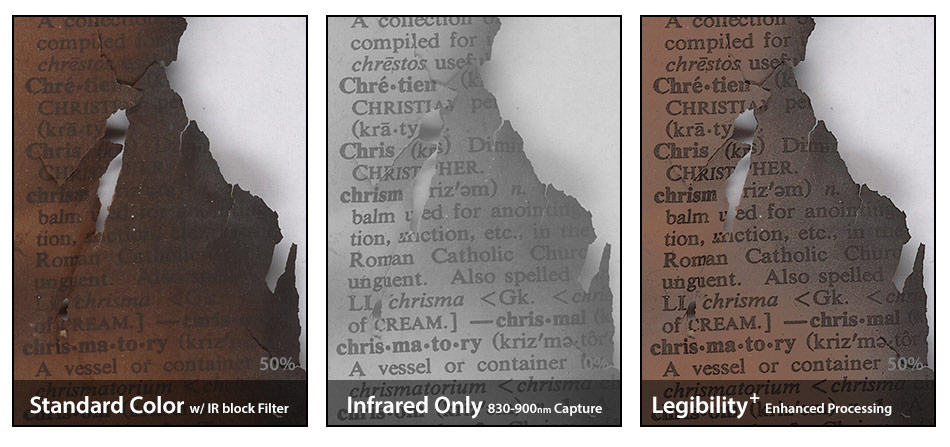Bringing Infrared into our Rapid Capture and Preservation-Grade Quality Toolkit: A Case Study
The Digital Transitions Division of Cultural Heritage is dedicated to providing tools that combine a high rate of capture with image quality that exceeds FADGI 4-star and strict METAMORFOZE guidelines. While these guidelines do not provide any requirement to include infrared capture we feel it is an important consideration for many cultural heritage applications.
Because infrared light is not visible to the human eye it is impossible to know, by visual inspection, whether or not an infrared capture of an object will provide any additional information about that object. An example of where infrared capture completely reveals hidden content of an object is one that has been charred by heat and/or fire damage. In such documents infrared capture can often provide a clear image of the original content even in cases where the original content is completely obscured in the visual spectrum.
Case Study: Fire-Damaged Documents
In a recent case study of our upcoming infrared offerings we produced a series of tests comparing visible and infrared capture of a heavily burned dictionary. We used a prototype of the DT Multispectra with an 80MP digital back to produce two raw files: visible-only and infrared-only (830nm – 900nm). The page size of the fire-damaged dictionary was around A4 which, with the resolution of the DT Multispectra, allowed us to capture four pages simultaneously at 400ppi (we could have instead captured two pages simultaneously at 600ppi or a single page at 800ppi). In this configuration we estimate a two-person digitization team could image 1500 pages per hour in both spectra depending on the fragility and object handling considerations.
The results exceeded our expectations and indicate a very high value to infrared capture for collections of this type. It provides two significant improvements to visible-only capture:
- Decreased intra-page contrast leading to increased legibility, especially in areas with moderate charring
- Discovery of text and illustrations which were entirely obscured in the visible spectrum by heavy charring
Since the DT Multispectra can quickly switch between visible-only and IR-only capture a standard color image was also captured to preserve the document in its burnt state. In addition, we produced a version of the documents with our Legibility+ processing (a unique combination of Capture One algorithms and scripting in Photoshop) to combine the legibility of the infrared image with the natural appearance of the standard color image. The resulting Legibility+ files could be used by researchers who need to see any obscured text/illustrations but wish to examine such details in the context of a standard color document.
See some of the results below, and contact us for full-resolution test files or any questions.
If you would like more information, please contact us.
Contact Us:
Division of Cultural Heritage
Peter Siegel
[email protected]
1.877.f/ortless (367-8537) x228


